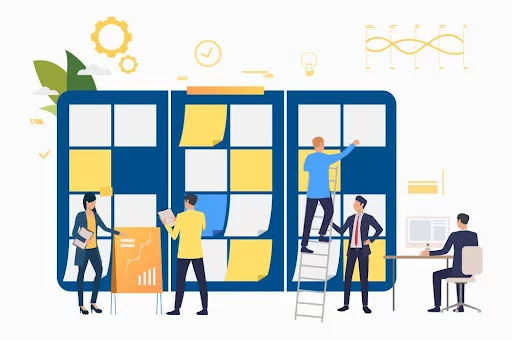
The meaning, questions and process of a retrospective
In all areas of life, if we do not learn from the past, if we do not learn the right lessons, we will make the same mistakes again. Business is no different. This is precisely the problem that retrospection, which is so common in agile project management, is designed to solve. This article explains the meaning and purpose of retrospectives, how they are conducted and how to schedule them.

The meaning and definition of retrospective
Retrospective literally means "looking back". And a retrospective meeting is, in keeping with the original meaning of the word, a retrospective ceremony in which the team reflects on what has happened in the previous period and identifies the next steps for improvement. Retrospectives originated in agile software development - agile teams hold such meetings at the end of each iteration.
However, it is also advisable to carry out a retrospective review, preferably on a regular basis, for organisations with a traditional operation.
Key questions for the retrospective
The following questions should be asked during the retrospective:
- What worked well in the previous period?
- What are the challenges that have arisen?
- What can we do to improve the process?
In an agile retrospective, the team reflects on how things went in the previous iteration and what changes are needed for the future. The meeting is team-centred: the team members decide together how the ceremony will take place and how decisions on improvements will be made, but of course the scrum master effectively supports them in this too.
How to prepare for the retrospective?
Preparations
The first step is to have a whiteboard where you will write "What worked well", "What needs to be improved" and "Action plan" in 3 different columns. You will also need to prepare a Post-it pad and writing utensils.
If the team is not physically in the same place, you can create a shared whiteboard with the 3 columns in a teamwork support application such as Mural.
Setting up rules
If you have done a retrospective before, touch on previous topics to give a sense of continuity. Be clear about exactly what time period the meeting will cover - it could be the last sprint, the last quarter or the project as a whole.
In addition, it is worth clarifying the following rules:
- Let's not get personal and take the comments personally!
- Let's try to be open to the challenges and ideas raised!
- Consider everyone's experience as valid!
- Focus on progress and try not to blame anyone!
Answering the questions
First, let's answer what was good in the previous period!
Each team member writes down their own ideas. It is a good idea to write one idea per slip of paper. Once the team members have finished, collect the slips and group similar or repetitive ideas. Finally, go through each comment and discuss it with the team.
The second point is to map the challenges, as before: by collecting, organising and discussing ideas.
The action plan is also set up in a similar way to the previous points, but it is important to prioritise the tasks and set measurable targets. These actions will be launched as soon as the meeting ends.

Closing the retrospective
Finally, it is worth taking a few minutes to evaluate the meeting itself and thank the team for their work and contribution
How much time should we allow for the retrospective?
The agile retrospective can of course be customised as needed, but the following schedule usually works well depending on team size:
- Preparations, sclarification of rules - 10 minutes
- What did we do right? - 15 minutes
- What could be improved? - 15 minutes
- Action Plan - 15 minutes
- Closure - 5 minutes
Total: 60 minutes
Concluding thoughts
Although retrospective reviews sometimes reveal serious problems, it is more common to focus on the continuous improvement of existing processes and habits. It is very important to keep in mind that the focus should never be on blaming individuals and finding fault, but on constructive debate.
To this end, it is worth exploring the underlying causes of certain habits and behaviours. The aim is that participants leave the meeting with an understanding of how others have experienced the previous period.
As such, retrospective meetings can be extremely valuable for improving team dynamics, productivity and processes.
HOW CAN WE HELP?
In the past years, our colleagues with agile coaching, product ownership, development and consulting/training experience have supported dozens of agile teams and organisational agile development processes.
We are not agile evangelists, we do not believe that agile trends are the solution to everything. We believe that these tools can help in everyday life, and that incorporating this way of thinking into day-to-day work to the right extent can bring short-term success for projects and organisations.
If you want to learn more about the basics of agility, scrum or kanban, we recommend our agile training.
Have a question? Contact us!

 Designabc
Designabc